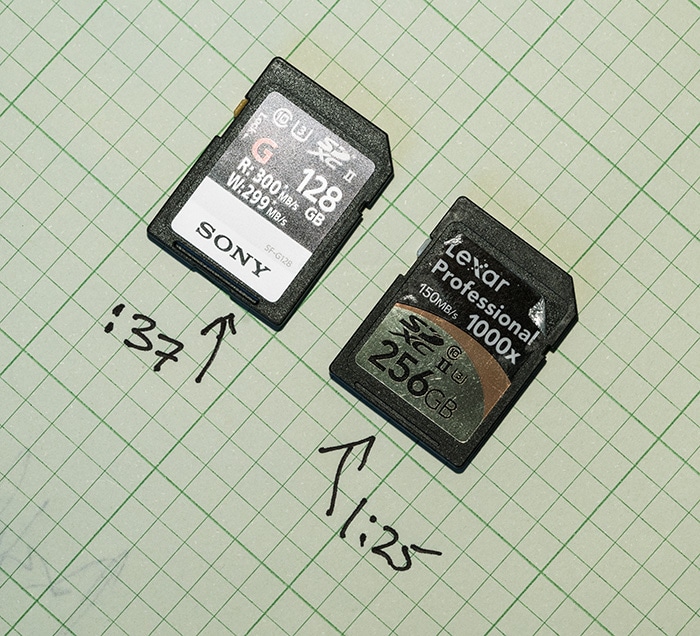This is the 24th in a series of posts on the Sony a9. The series starts here.
When it comes to SD cards for the a9, there are two kinds of fast:
On the right, a card that used to be the state of the art when it came to SD card speed. It’s rated at 150 MB/s. If the a9’s 6 GB buffer emptied at that speed, it would take about 40 seconds to empty it. In fact, it takes more than twice that long. I figured that the camera was the limiting factor, not the card, so using a faster card wouldn’t make much difference.
I figured wrong.
Using Sony’s new speed demon, which at rated speed could empty the buffer in 20 seconds, gets you a rate that is a bit less than half that, and twice as fast as the Lexar card. Color me impressed.
By the way, with the Sony card it only takes 33 seconds to clear the buffer with uncompressed files. Probably the reason it’s shorter with uncompressed files is that, since there are fewer files, there is less file system overhead.
Experimental protocol:
- Compressed raw
- Full size files
- ES enabled
- Continuous high drive mode
- 1/8000 second
- MF lens
- FW version 1.00
- ISO 2500
- Recording mode: Standard
- Freshly formatted SD card
- Hold down the shutter release until the buffer fills
- Take your finger off the release
- Time how long it takes before the red light goes out.

Hi Jim,
If possible can you do a quick test on the A7Rii with the Sony card to see if there is any benefit? Thanks.
There is none.
Thanks for doing this. But the Lexar equivalent to the new Sony card would be the Lexar 2000X. I wonder how different results from that would be from the new Sony. I suspect they would be very close.
Thanks. I’ll check that out. I wasn’t suggesting that the Lexar card I used was equivalent. I just happened to be using it before the Sony arriveed, and it was the fastest thing I had lying around.
Hi!
There is a site that makes tests of lots of memory cards and cameras. They’ve tested Sony A9 and actually “Lexar Professional 2000x UHS-II 64GB” is by a tiny bit faster then the Sony SF-G.
Here is the link for Sony A9 review: https://www.cameramemoryspeed.com/sony-a9/fastest-sd-cards-uhs-i-vs-uhs-ii/